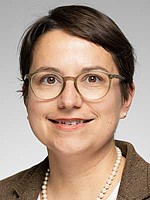Microgels and Soft Colloids
Session Chairs
Walter Richtering (RWTH Aachen University, Aachen, Germany)
Julian Thiele (Otto von Guericke University, Magdeburg, Germany
Invited Speakers

Jérôme Crassous (RWTH-Aachen, Germany)
Supramolecular Restructuring of Ultra-low Crosslinked Microgels
Ultra low crosslinked (ULC) PNIPAM microgels were supramolecularly complexed by adding tannic acid, a polyphenol. Hereby, the additional physical crosslinking through hydrogen bonds dramatically impacted both the structure and properties of the microgels as demonstrated by scattering and electron microscopy experiments. Supported by molecular dynamic simulations, we reveal how the affinity of the tannic acid to the polymer directs the structural transformation of ULCs from soft fuzzy to hard capsule-like structures. This versatile dynamic control ultimately enables the simultaneously targeted encapsulation of hydrophilic drugs in the core and uptake of hydrophobic drugs in the shell of the supramolecular microgel capsules.

Matthias Karg (U. Halle, Germany)
Soft colloids at interfaces
Microgels tend to absorb to various interfaces where often self-assembly into periodic structures is observed. We study the phase behavior of various (core-shell) microgels at air/water interfaces by different in situ techniques. Comparison of the microstructure that is obtained after the transfer onto solid interfaces (ex situ) reveals strong influences of capillary interactions altering the microgel arrangement. The observed changes depend on substrate wettabiliy, microgel softness, interparticle distance and transfer conditions. We aim to shine light on the role of the different parameters in order to better understand the complex phase behavior of 2-dimensional assemblies of soft colloids.


Valérie Ravaine (ISM Bordeaux, France)
Responsive microgels at liquid interfaces: from oil-in-water to water-in-water emulsion stabilization
Microgels are colloidal particles made of swollen lightly cross-linked polymers, whose softness imparts peculiar properties when adsorbed at liquid interfaces. In particular, they can deform and adopt different conformations. We will discuss their ability to stabilize oil-in-water emulsions and even water-in-water emulsions that can destabilized on demand thanks to their stimulus-responsiveness.

Ulrike van der Schaaf (KIT Karlsruhe, Germany)
Microgels in Food Applications
Several food-grade polysaccharides can be used to prepare microgel particles. We use pectin as a model system to investigate fundamental structure–function relationships in such networks. Specifically, we explore how pectin-based MGP stabilize oil-in-water emulsions by combining interfacial adsorption with network contributions, and how they modify the structure and texture of fermented protein gels through particle–matrix interactions. These examples show how polysaccharide-based microgels can be applied to design and control food structures.
Contributed talks and posters
... will be continuously added until the abstract acceptance deadline.